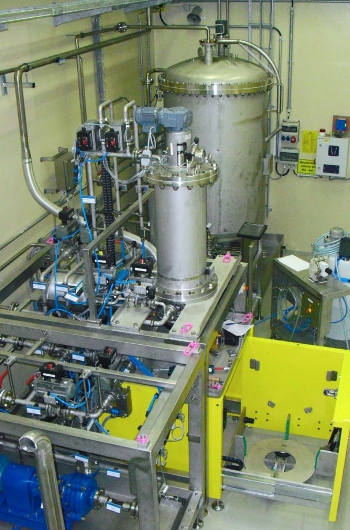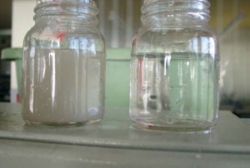
Westinghouse chamber filtration system
Background
Removal of particles from liquid waste is one of the most important steps in liquid radioactive waste treatment to get rid of particle-bound activity and protect downstream processes.
The Westinghouse chamber filtration system consists of a chamber filtration unit, a feed tank with pump, a permeate tank with pump, a filtration additive tank with pump and a reject system with a Westinghouse-design docking station for the drums. Chamber filtration can tolerate various solid concentrations and build up its own filter layer; therefore, it is particularly well suited for sludge and other similar fluid mixtures. Filter additives can be used, if necessary and no filter cartridge waste is created.
Description
Chamber filtration removes various particles from water. The feed is transferred from the feed tank into the chamber filtration unit, where the water is filtered. The permeate is routed to a permeate tank for release or further treatment. The particles are removed from the cylindrical filter and rejected into a docked drum. The chamber filtration unit is a cylindrical stainless steel basic-filter structure. The filter width can be chosen according to the requirements (e.g., 100 µm). During the circulation of a filtration batch, blocking of the filter is avoided by establishing a fine filtration layer on the steel filter structure. This layer may be established by the solid content in the feed or by filtration additive, depending on the feed. A fine filtration layer is established in circulation mode with a thickness of about 0.5 to 1.0 mm. During the filtration of a batch, this fine filtration layer allows the growing of a filter cake up to 5 cm. The chamber filtration interrupts the filtration batch automatically when the filter cake grows too large and starts an automated cleaning. Then, the system is emptied, compressed air dries the filter cake, and a scraper blade rejects the filter cake into a docked drum. The chamber filtration is operated in a continuous batch process.

Water sample before and after chamber filtration
Benefits
The benefits offered by chamber filtration include the following:
- Various feed compositions can be filtered; e.g., bead resin or powder resin dewatering, filtration of waste water from reinforced concrete cutting, etc.
- A filtration additive may be applied for a wide variation of feed compositions.
- A filter cake has deep bed filtration properties.
- Additional filtration units with a drum docking station can be added as modules.
- Filters are available from 0.25 m² up to a 1.85 m² filtration surface (basic-filter structure).
- Automatic cleaning of the basic-filter structure and rejection of the dewatered product into the docked drum are provided.
- Equipment is skid mounted with a small footprint and thus easy to transport.
Experience
Westinghouse has supplied seven nuclear power plants in Germany with chamber filtration systems, with the first one in 2003 and the most recent in 2014.



